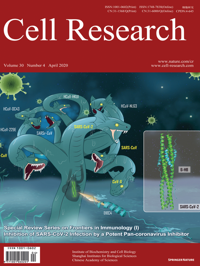
Volume 30, No 4, Apr 2020
ISSN: 1001-0602
EISSN: 1748-7838 2018
impact factor 17.848*
(Clarivate Analytics, 2019)
Volume 30 Issue 4, April 2020: 360-362
LETTERS TO THE EDITOR
Cryo-EM structure of full-length α-synuclein amyloid fibril with Parkinson’s disease familial A53T mutation
Yunpeng Sun 1,2 , Shouqiao Hou 1,2 , Kun Zhao 1,2 , Houfang Long 1,2 , Zhenying Liu 1,2 , Jing Gao 1,2 , Yaoyang Zhang 1,2, Xiao-Dong Su 3 ,Dan Li 4,5 and Cong Liu 1,2
1Interdisciplinary Research Center on Biology and Chemistry, Shanghai Institute of Organic Chemistry, Chinese Academy of Sciences, Shanghai 201210, China; 2University of Chinese Academy of Sciences, Beijing 100049, China; 3State Key Laboratory of Protein and Plant Gene Research, and Biomedical Pioneering Innovation Center (BIOPIC), School of Life Sciences, Peking University, Beijing 100871, China; 4Bio-X-Renji Hospital Research Center, Renji Hospital, School of Medicine, Shanghai Jiao Tong University, Shanghai 200240, China and 5Bio-X Institutes, Key Laboratory for the Genetics of Developmental and Neuropsychiatric Disorders, Ministry of Education, Shanghai Jiao Tong University, Shanghai 200030, China
These authors contributed equally: Yunpeng Sun, Shouqiao Hou, Kun Zhao
Correspondence: Dan Li (lidan2017@sjtu.edu.cn) or Cong Liu (liulab@sioc.ac.cn)
Dear Editor,
α-Synuclein (α-Syn) forms amyloid fibrils accumulating in Lewy bodies (LB) and Lewy neuritis (LN), which is a common histological hallmark of Parkinson’s disease (PD) and other synucleinopathies.1 Moreover, α-syn amyloid fibrils spread in the patient’s brain via cell-to-cell transmission, which accounts for the disease progression.2 Several single amino-acid mutations of α-syn, including A53T, E46K, H50Q, G51D, A30P and A53E, have been identified from familial PD patients, which are causative to the early-onset pathology with different clinical symptoms.3 Among them, A53T is the first hereditary mutation of α-syn discovered in Italian and Greek families with autosomal dominant and early-onset PD.4 Till now, A53T represents the most commonly reported cases of familial PD involving more than 10 families of Greek, Korean, Swedish and Chinese origin.3 A53T mutation promotes α-syn fibril formation in vitro, and exhibits exacerbated PD-like pathology both in cellular and animal models.5,6 Previous structural studies on the wild-type (WT) α-syn fibril reveal that A53 is one of the key residues in the interface of α-syn protofilaments.7,8,9 However, it remains unclear how the A53T mutation may alter the fibril structure and exacerbate α-syn pathology.
FULL TEXT | PDF
Browse 981


